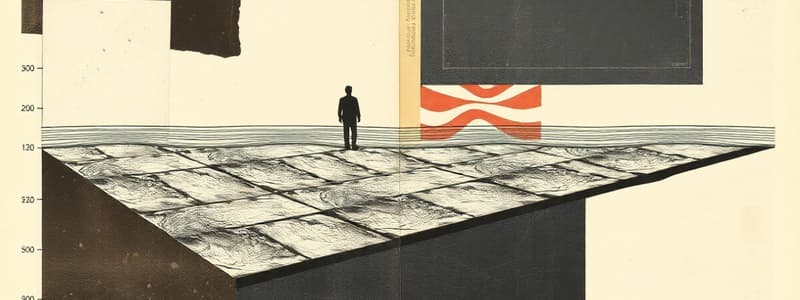Podcast
Questions and Answers
What is the approximate depth of investigation for a Wenner array in a uniform medium?
What is the approximate depth of investigation for a Wenner array in a uniform medium?
- 15%
- 25%
- 30% (correct)
- 20%
Which electrode configuration typically has the highest depth of investigation?
Which electrode configuration typically has the highest depth of investigation?
- Wenner (correct)
- Gradient
- Dipole-dipole
- Schlumberger
How does increasing the distance between the potential electrodes (MN) and current electrodes (AB) affect measurement?
How does increasing the distance between the potential electrodes (MN) and current electrodes (AB) affect measurement?
- It decreases the depth of investigation.
- It weakens the potential difference measured.
- It reflects less on deeper layers.
- It enhances the potential difference measured. (correct)
What does the resistivity of the ground primarily determine?
What does the resistivity of the ground primarily determine?
What is a primary challenge that can affect resistivity measurements?
What is a primary challenge that can affect resistivity measurements?
Which of the following is NOT a factor that influences the depth of investigation?
Which of the following is NOT a factor that influences the depth of investigation?
In resistivity surveys, deeper penetration is achieved by which of the following actions?
In resistivity surveys, deeper penetration is achieved by which of the following actions?
Which array type typically has a depth of investigation of only 20% of the current electrode separation?
Which array type typically has a depth of investigation of only 20% of the current electrode separation?
What effect does wider electrode spacing have on a survey?
What effect does wider electrode spacing have on a survey?
Why is survey line orientation important in geological surveys?
Why is survey line orientation important in geological surveys?
What do measurement stations in a resistivity survey primarily ensure?
What do measurement stations in a resistivity survey primarily ensure?
Current electrodes should be placed where during data acquisition?
Current electrodes should be placed where during data acquisition?
What challenge does electrode configuration influence?
What challenge does electrode configuration influence?
What is essential for obtaining comparable data between different survey lines?
What is essential for obtaining comparable data between different survey lines?
During data acquisition, what must be maintained regarding the electrical current injected into the ground?
During data acquisition, what must be maintained regarding the electrical current injected into the ground?
What practical considerations must survey line orientation account for?
What practical considerations must survey line orientation account for?
What is the primary purpose of instrument calibration in resistivity surveys?
What is the primary purpose of instrument calibration in resistivity surveys?
Which electrode configuration is most suitable for assessing deeper structures?
Which electrode configuration is most suitable for assessing deeper structures?
What should be included in a safety protocol for resistivity surveys?
What should be included in a safety protocol for resistivity surveys?
Which statement about grid layouts in resistivity surveys is correct?
Which statement about grid layouts in resistivity surveys is correct?
What challenge might influence resistivity readings during surveys?
What challenge might influence resistivity readings during surveys?
In which situation is a line layout more appropriate for resistivity surveys?
In which situation is a line layout more appropriate for resistivity surveys?
What is a potential hazard that should be considered before conducting a resistivity survey?
What is a potential hazard that should be considered before conducting a resistivity survey?
Which configuration would be least effective for shallow investigations?
Which configuration would be least effective for shallow investigations?
What can lead to erroneous resistivity calculations?
What can lead to erroneous resistivity calculations?
What is the role of potential electrodes in resistivity measurement?
What is the role of potential electrodes in resistivity measurement?
Why is accurate data recording crucial during a resistivity survey?
Why is accurate data recording crucial during a resistivity survey?
What should be regularly checked during a resistivity survey?
What should be regularly checked during a resistivity survey?
Which quality control measure is important during data acquisition?
Which quality control measure is important during data acquisition?
What can enhance the accuracy and reliability of resistivity data?
What can enhance the accuracy and reliability of resistivity data?
What does the post-processing phase in resistivity surveys entail?
What does the post-processing phase in resistivity surveys entail?
What is a primary purpose of maintaining consistent electrode spacing?
What is a primary purpose of maintaining consistent electrode spacing?
How does the presence of a cliff affect resistivity measurements during surveys?
How does the presence of a cliff affect resistivity measurements during surveys?
What is the recommended solution when conducting measurements near a cliff or road cut?
What is the recommended solution when conducting measurements near a cliff or road cut?
What happens if one electrode is not moved while the other is during measurements?
What happens if one electrode is not moved while the other is during measurements?
What is a consequence of moving an electrode too far away during geophysical surveys?
What is a consequence of moving an electrode too far away during geophysical surveys?
What effect does leakage in cables have on resistivity measurements?
What effect does leakage in cables have on resistivity measurements?
How does a wire-mesh fence affect the readings during measurements?
How does a wire-mesh fence affect the readings during measurements?
What is the effect of improperly marking positions of electrodes?
What is the effect of improperly marking positions of electrodes?
What impact do irregularities in the ground, such as cliffs or fences, have on geophysical surveys?
What impact do irregularities in the ground, such as cliffs or fences, have on geophysical surveys?
Flashcards are hidden until you start studying
Study Notes
Depth of Investigation (DOI)
- DOI indicates how deep into the ground data can provide reliable information about subsurface resistivity.
- DOI is influenced by electrode array geometry.
- Wenner, dipole-dipole, and Schlumberger arrays have DOIs that are approximately 30%, 25%, and 20% of their current electrode separation, respectively.
- Electrode spacing can be manipulated to achieve sufficient depth.
Parameters Affecting the Depth of Investigation
- The length of the current electrodes (AB line) and the distance between the current electrodes (AB) and the potential electrodes (MN) influence the depth of investigation.
- Different electrode configurations have unique advantages and limitations for depth penetration, lateral resolution, and field setup.
Factors Affecting Measurements
- Resistivity of the Ground (ρ): High resistivity materials (like hard rock) produce stronger signals, while low resistivity materials (like clayey soils) produce weaker signals.
- Ground Water: The presence of groundwater can significantly alter resistivity measurements, as water is a good conductor of electricity.
- Soil Moisture: Soil moisture content can influence resistivity, as moist soil generally has lower resistivity than dry soil.
- Instrument Calibration: Proper calibration ensures accuracy and reliability of measurements, including verifying instrument settings, cables, and electrodes.
- Safety Considerations: Identify potential hazards at the site and implement safety protocols to mitigate risks associated with power lines, unstable terrain, or weather conditions.
Survey Design and Layout
- Electrode Configuration Selection: Choose appropriate electrode configurations like Wenner, Schlumberger, or dipole-dipole based on factors like depth and resolution requirements.
- Grid or Line Layout: Use a grid layout for large-area mapping or a line layout for detailed profiling of specific geological features.
- Electrode Spacing and Array Geometry: Plan electrode spacing and array geometry carefully to meet depth and resolution requirements. Wider spacing increases depth but can reduce resolution. Adjust spacing based on geological conditions.
- Survey Line Orientation: Orient survey lines perpendicular to the expected strike of subsurface structures to maximize contrast in resistivity readings.
- Measurement Stations: Distribute measurement stations systematically to ensure full coverage and consistent data acquisition.
Data Acquisition Techniques
- Current and Potential Electrode Placement: Install current electrodes at the ends of survey lines for uniform current injection, and place potential electrodes according to the chosen configuration to measure voltage differences.
- Current Injection: Maintain stable current magnitude throughout the survey to ensure consistent measurements. Fluctuations in current levels can lead to inaccuracies.
- Potential Measurement: Measure the voltage potential between pairs of potential electrodes and record readings at each station.
- Data Recording: Record data with a data logger or digital recording system, documenting relevant parameters like electrode spacing, instrument settings, and environmental conditions.
- Survey Progression: Progress systematically across the layout, maintaining consistent electrode spacing and following the designed configuration.
- Quality Control: Implement quality control measures to identify and correct potential issues, such as checking electrode contact resistance, instrument performance, and data consistency.
- Repeat Measurements: Repeat measurements or use multiple electrode configurations to enhance accuracy and reliability.
- Post-Processing: Use data inversion and interpretation techniques to create a subsurface resistivity model from raw data, allowing for the identification of geological features or anomalies.
Field Effects Upon Measurements
- Effect of a Cliff or Road Cut: Cliffs and road cuts disrupt the flow of electrical current, leading to inaccurate measurements. Place electrodes at least one electrode spacing away from these features.
- Effect of a Wrong A or B Moving Electrodes:
- Shortened Distance: Abnormally high resistivity values due to concentrated current flow.
- Overshooting the Distance: Abnormally low resistivity values due to dispersed current flow.
- Effect of Leakage in Cables: Current leaks into the ground at the point of leakage, leading to a drop in the displayed value.
- Effect of Wire-Mesh Fence: Current flows into the ground at the fence instead of the new electrode position, causing unexpected drops in resistivity due to higher current density.
Conclusion
- Electrical resistivity method provides a valuable tool for characterizing subsurface geological conditions.
- Understanding the principles of DOI, electrode configurations, field effects, and data acquisition techniques ensures accurate and reliable results.
- Proper planning, execution, and data analysis are essential for successful resistivity surveys.
Studying That Suits You
Use AI to generate personalized quizzes and flashcards to suit your learning preferences.




